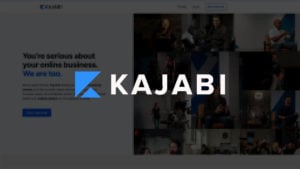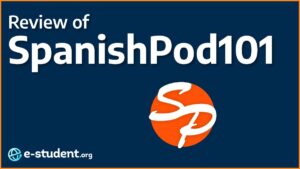“Learning the art of programming, like most other disciplines, consists of first learning the rules and then learning when to break them.”
― Joshua Bloch
One of the most popular programming languages out there (ranked above Python, PHP, and R), Java is used by more than 40% of developers around the world.
What makes Java so appealing? To start with, Java is incredibly versatile. You can use it for everything from building desktop and mobile applications, implementing Internet of Things (IoT) devices, and even making games (fun fact: the best-selling video game Minecraft was first written in Java).
Additionally, Java is super portable. It can run on almost any system, including Windows, Mac, and Linux. It’s also the official language for Android App Development. Most of the apps you see in the Google Play Store were built with Java (especially banking applications — financial services love Java).
But it’s not just apps that are built with Java. Because Java is a server-side language (it lets you tailor website content for individual users, for example, someone who signs up on a page) and is easy to scale, it’s a top choice for growing startups and tech giants. Google, Amazon, Netflix, Twitter, Spotify, and Uber all use Java in their tech stacks. As James Governor has said, “when web companies grow up, they turn into Java shops.”
As if all that wasn’t enough, Java is also open-source, fast, and powerful. Plus, it has huge community support and is suitable for beginners as well.
Still not convinced a Java course is worth taking? What if we told you that knowing how to code in Java will make your employability skyrocket? According to Dice, Java was one of the most in-demand programming languages on the job market in 2020. For example, in February 2020, there were almost 4,000 job postings for Java developers/engineers. That same month, Java was the second-most requested skill in job ads. As of right now, there are nearly 40,000 jobs for “Java developers” and over 700 jobs for both “Java developer back office application” and “Java developer front office application” on Indeed.
Java developer is a hard job role for companies to fill. It’s only fair that as a Java developer, you can expect to receive generous compensation — the average base salary for a Java developer in the U.S. is $105,070 as of writing this article.
Ready to start, or continue, your journey towards becoming a well-respected and well-paid Java developer? If so, take a look at seven of the best Java courses beginners and intermediate learners alike will love.
Without further ado, these are the very best online Java courses:
Best Java Courses
Best Overall: Java Programmer Nanodegree (Udacity)
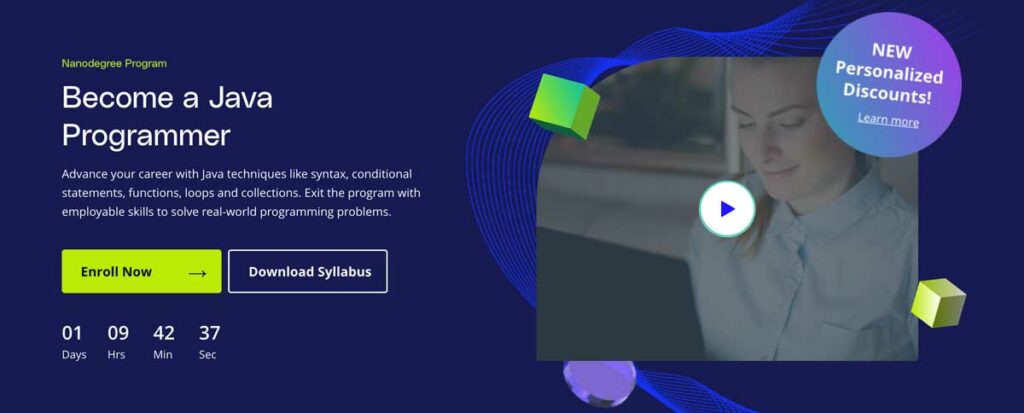
- Can take any committed learner from no Java knowledge to employable skills
- Focuses on hands-on projects and practical scenarios
- Personalized mentor feedback
- Career support services included
Cons
- Not for absolute programming beginners – need familiarity with basic concepts
- If not a committed learner, it can become expensive if having to extend access beyond the standard length
For serious learners who already know that they need to use Java in their existing job or want to launch a new career with Java programming as their starting point, the best program we can recommend is Udacity’s Java Programmer Nanodegree. Without carrying the price tag of full-blown boot camps (like Springboard), it still provides a well-designed project-based curriculum with full review support, 1-on-1 mentoring, and career support services that help you gain the real-world skills to be able to join a team as a junior Java developer.
The syllabus of the Java Programmer Nanodegree is divided into three courses; each centered on a significant practical project that will help you build your portfolio and demonstrate your problem-solving skills to employers:
- Java Fundamentals: Introduces basic concepts of basic Object-Oriented Programming (classes, encapsulation, inheritance, etc.) and more specific Java concepts (collections, exceptions, common types, etc.). This course has you building a fully functioning hotel reservation application.
- Advanced Java Programming Techniques: Focuses on the lesser-known features of Java, such as functional programming, I/O, serialization, and reflection. The project for this course is updating a legacy web crawler to use concurrency for added efficiency.
- Java Application Development: Introduces the necessary tools and skills for developing product-ready applications so that you can compile, package, execute, and test your code. You’ll be using Maven in the project for this course, in which you will be refactoring an existing program to be able to scale it.
If this curriculum seems too basic to you and you already have intermediate Java skills but want to take them to the next level, Udacity has a separate Nanodegree program called “Java Developer,” which is equally well structured but has a higher-level starting point, assuming familiarity with OOP and basic Java concepts.
The Nanodegree does not have any formal prerequisites; however, the tempo is relatively high, so you may struggle to keep up if you are unfamiliar with programming. Taking Udacity’s Intro to Programming Nanodegree is an excellent option for those starting without any prior knowledge – but if you want a more self-directed, albeit more basic, introduction to programming concepts (including a free option), try out Codecademy’s “Learn How to Code.”
There’s a minimum 15% discount on paying upfront for the expected duration of the course rather than paying month-to-month. Most learners who can commit the recommended amount of time can finish the course in the expected number of months (three in this case) – but it’s important to note that while you can take your time and finish the course later, you will need to pay the regular monthly subscription during this time. This is not necessarily by greed on the part of Udacity – it is also arguably in the students’ interest as it leads to much higher completion rates than other models.
Overall, we found that Udacity’s Java Programmer Nanodegree has a more well-thought-out approach to the topic than the others on this list, guiding students to have a more holistic view of development, including basic user interface design and using actual tools and approaches they would find in a work environment. For this reason, it is our #1 recommendation in the Java category for 2022.
Best University-Led Course: Object-Oriented Programming in Java Specialization (Coursera x Duke University & UC San Diego)
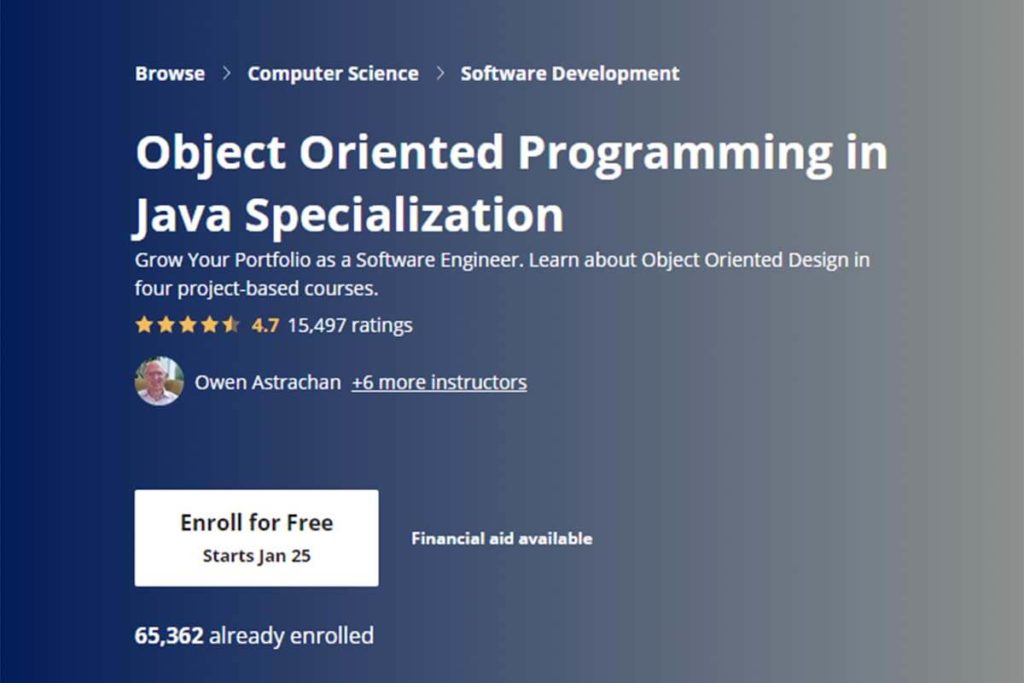
40% ($140 USD) off your first year of Coursera Plus Annual (expires 2 December 2024)
- Well-designed university-led course
- Features exciting mini-projects
- Learn Java programming in 5 months
- Impressive learner career outcomes /li>
Cons
- Previous programming skills required
- Challenging projects which would benefit from more guidance
Duke University and University of California San Diego come together to deliver Object-Oriented Programming in Java Specialization. This course aims to impart students with software engineering skills applicable across a range of industries.
As the title of this course makes it quite clear, one of the main Java concepts covered here is object-oriented programming (OOP). That makes sense. After all, Java is an object-oriented programming language.
However, the course, which is split into four smaller courses, also goes over the fundamentals of coding in Java, development environments (namely BlueJ and Eclipse), data structures, and building graphical user interfaces. Note that it is possible to enroll in just one or more of the component courses, in case that fits your learning objectives better.
All four courses contain Java tutorials, assignments, and readings and end with a mini-project. For example, at the end of course two, which teaches Java through the application of cryptography, you’re tasked with writing your own encryption program and a separate program to break your encryption algorithm.
Most students complete all four courses in about five months, provided that they spend six hours a week studying. That being said, the exact timeframe may depend on your current skill level. Given the length of the program, you may be better off with an annual Coursera Plus subscription. Note that this program is meant for individuals with prior programming experience as there is quite a bit of coding involved from the outset.
One of the best Java courses out there, the Object-Oriented Programming in Java Specialization will provide you with a solid understanding of how OOP works at a high level. While the Specialization isn’t easy, your efforts will almost certainly pay off. According to learner career outcomes, 40% of students started a new career after finishing this course, and nearly 20% received a promotion or pay increase.
Best Overview: Java Language Fundamentals (Pluralsight)

- Collection of courses covering basic and advanced topics
- Tests your current Java skills
- Includes coding challenges
- Learn Java programming language in 50 hours
Cons
- Lacks real-world projects
Want to get the hang of Java but don’t know where to start? Pluralsight’s Java Language Fundamentals path is a collection of courses that will teach you the essentials of Java one concept at a time until you – the idea is – reach Java mastery.
This path is broken down into three levels: Beginner, Intermediate, and Advanced. Beginner-level courses focus on creating classes and applications and using maps and sets. By the end of the Beginner level, you should be able to write your own simple Java applications. Intermediate-level courses show you how to work with generics and nulls, use lambda expressions, and make your code more object-oriented. Finally, the advanced courses teach you how to use relational databases and APIs.
Most courses consist of video lectures. However, some courses are marked as “interactive,” meaning they include both videos and in-browser coding challenges.
Before you start this path, you’re prompted to take a “Skills IQ” test. Skills IQ is a short test that will measure your knowledge of Java and tell you your current level. That way, you can develop your skills in the correct order, regardless of whether you’re a complete novice when it comes to core Java concepts or have prior experience with the programming language already.
Each course is between 20 minutes and seven and a half hours long, with most courses falling somewhere in the middle. The entire path (21 courses) takes about 50 hours to complete.
Pluralsight’s Java Language Fundamentals is a collection of courses that will take you from beginner to advanced level knowledge. Nonetheless, the best thing about this path is that it tests your current skills. So, instead of having to waste your time watching courses that explain concepts you’re already familiar with, you can start at the level you are at right now and grow your knowledge organically. Although it doesn’t include any significant projects or guided coursework, it serves as a good overview of Java for anyone, and for the self-driven and independent learner, it can be a sufficient basis for mastering the language.
Best for Certification Prep: Java Programming Masterclass for Software Developers (Udemy)

New customer offer! Top courses from $14.99 when you first visit Udemy (expires 31 March 2024).
- No previous coding skills required
- One-stop-shop for everything Java
- Features 50 coding exercises
- Good preparation for the Oracle Java Certificate exam
Cons
- Some challenges are not always clear
- Lacks visuals
Udemy’s Java Programming Masterclass for Software Developers is a bestseller for a reason. Not only is this course one of the more comprehensive Java courses out there (with 80 hours of on-demand video and 50 coding articles). It’s also taught by Tim Buchalka, a popular Udemy instructor with 35 years of experience in software development and 20 years of experience in Java.
Throughout his long career, Tim has worked for numerous major companies, including Saab and Mitsubishi. Today, his courses are the go-to training material for developers at organizations like Mercedes-Benz, PayPal, and IBM. So, when Tim says that this course will drill down “the core Java skills needed to apply for Java developer positions,” he isn’t lying.
The course is split into 25 sections and 401 lectures. While at first glance, the length of the course may seem slightly overwhelming, keep in mind that it’s supposed to be “a one-stop-shop for Java.” In 2022, the course was updated to cover Java 11 and Java 17.
Accordingly, the course is divided into different sections, covering basic, intermediate, advanced, and optional material. For example, the material in section 13 explains how to build a graphical user interface, which isn’t something that all students will need (or want) to learn.
There are no prerequisites to enrolling in this program. However, students with knowledge of another programming language will find the intermediate and advanced topics easier to grasp than those who are completely new to the world of coding.
For thorough coverage of Java, you can’t go wrong with this course from Udemy, although, as with most courses on Udemy, there is not much support provided by the teacher to individual students. Still, it is one of the best courses on Java right now and comes with a 30-day money-back guarantee and prepares you for the Oracle Certified Associate, Java SE Programmer Certification exam (should you decide to take it).
Best for Bite-Sized Learning: Java Essential Training - Objects and APIs (LinkedIn Learning)
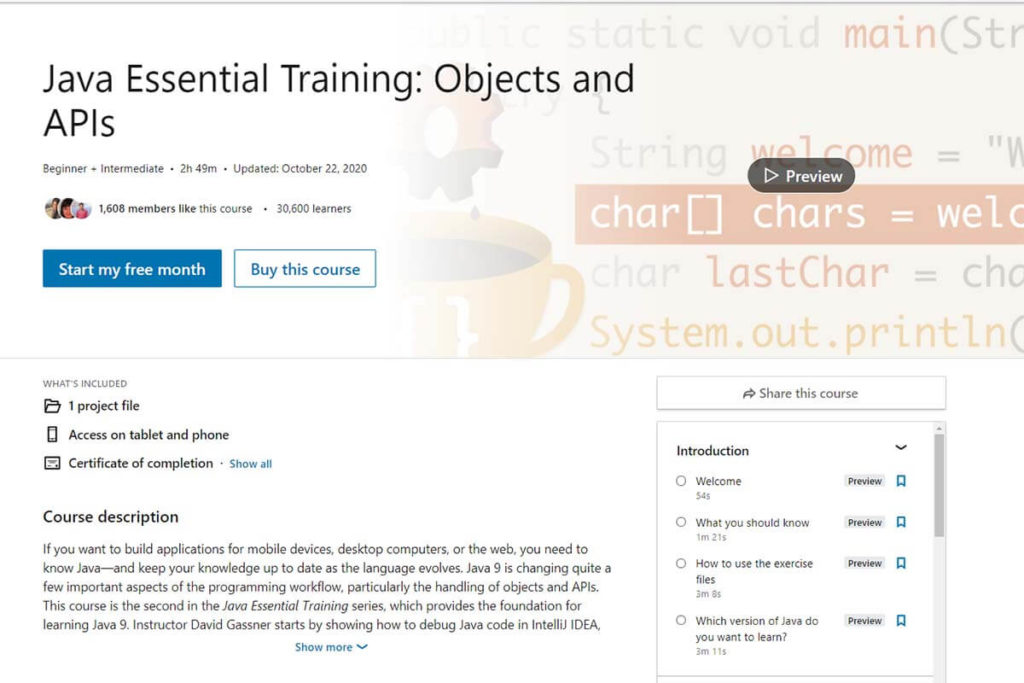
- Only 3 hours long
- Bite-sized lessons
- Certificate of Completion
- Features exercise files
Cons
- Not suitable as a comprehensive introduction to Java
Java Essential Training: Objects and APIs is a three-hour LinkedIn Learning course designed explicitly for developers who want to learn how to create successful applications, whether for the web, desktop, or mobile.
Keep in mind that this course is part two of the Java Essential Training series. If you’re new to Java, you may want to start with part one of the series: Java Essential Training: Syntax and Structure. Part one goes over the history, architecture, and syntax of Java. It also shows you how to get started with Java 9 and how to work with variables and string values as well as how to manage program flow.
Now, back to Java Essential Training: Objects and APIs. The learning objectives of this course include debugging Java code, handling exceptions, creating custom classes, managing data collections, using Java libraries, and deploying Java applications.
The course consists of six sections that are between 10 and 50 minutes long. However, each section is further broken down into video lessons, which can be anywhere from two to eight minutes long. Essentially, what this means is that you don’t have to dedicate a large amount of time to learning Java. Instead, you can learn Java in highly focused training bursts whenever you have some spare time.
The lectures are to the point. The lecturer explains each concept clearly, while also showing you how to code on his screen. Since the course comes with exercise files, you can follow along with the demonstrations in front of you.
Java Essential Training: Objects and APIs offers a solid foundation for working with Java 9. The course is well-organized, under three hours long, and comes with a Certificate of Completion. Thanks to the 30-day free trial of LinkedIn Learning, you could also complete this course for free. No wonder it’s one of the top Java courses on the market!
Best Fundamentals Course: Introduction to Java Programming (edX x uc3m)
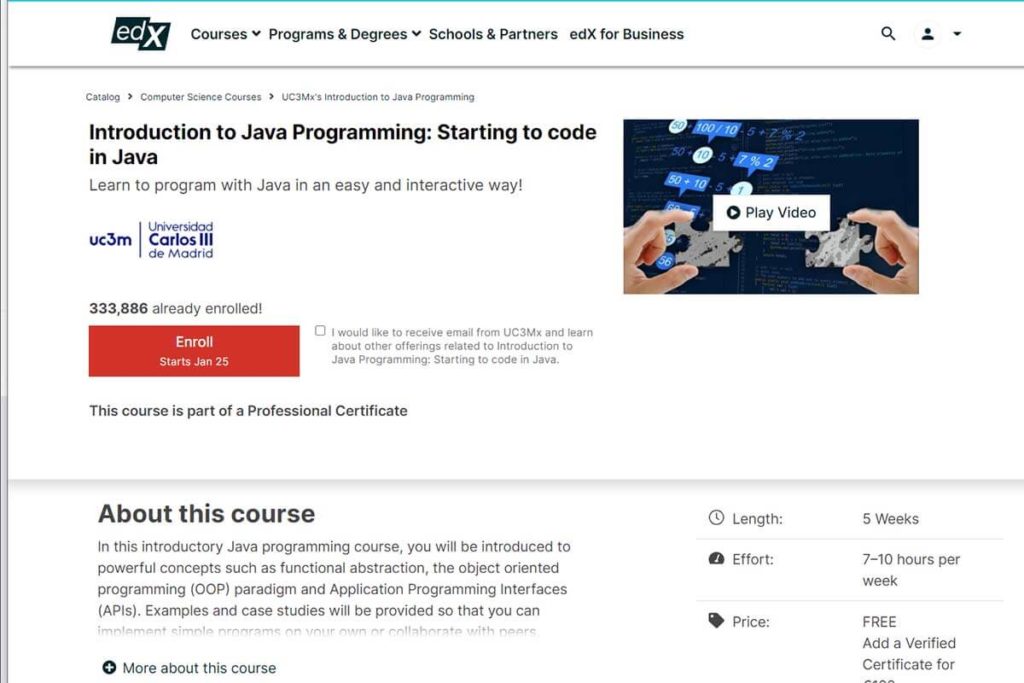
- No prior experience in software development required
- Includes visual, interactive exercises and graded assignments
- Enthusiastic instructors
- Course can be audited for free
Cons
- Instructors' articulation is not always fully clear
Designed by Universidad Carlos III de Madrid (uc3m), a Spanish university of international recognition, Introduction to Java Programming teaches Java fundamentals in a visual way.
This course is organized into three five-week modules. The first module looks at the basics of the Java programming language, like functional abstraction and object-oriented paradigm. The second module explores how to write “good” programs (i.e., programs that are efficient, correct, and ethical). Finally, the third module demonstrates how to deal with data structures.
As for the learning experience – the course is well structured, and the instructors (of which there are 12) are enthusiastic. They explain all the concepts in an easy-to-understand and humorous manner, so even complete beginners are not left behind. Although some people have complained about the instructors’ accents, each lesson comes with a transcript.
In addition to video lessons, this course also has lots of fun activities and graded assignments. However, some of the assignments, which involve reading, analyzing, and debugging code snippets, can be quite demanding. This is especially true considering that you only have one attempt at each question.
Each module takes between 5 and 10 hours to complete. You can finish the entire course in about four months, as long as you spend between six and eight hours studying each week.
The learning outcome of this course? To understand the basics of Java, of course, and to start thinking like a programmer. While you won’t become a pro in Java after taking this course, you’ll come away with a strong understanding of Java fundamentals, which will go a long way in helping you master this programming language down the line. For this reason, edX’s Introduction to Java Programming is one of the best Java courses you can study today.
Good Alternative: The Complete Java Certification Course (Udemy)

New customer offer! Top courses from $14.99 when you first visit Udemy (expires 31 March 2024).
- Features 17.5 hours on-demand video
- Experience in web development not requires
- Includes access to additional resources and three projects
Cons
- Lack of guidance for challenging projects
- Would benefit from more practical examples
The Complete Java Certification Course available on Udemy is a good option for beginners because it assumes no prior Java experience. However, more experienced programmers will gain something from this course but may need to skip ahead to more advanced topics.
The instructor, Imtiaz Ahmad, has extensive experience in big data technologies and has built financial software for companies like Goldman Sachs, S&P, and JP Morgan. The fact that he knows what he’s talking about is obvious. Not only does Imtiaz articulate each concept in great detail (and in simple language). He also explains the “why.”
The course itself consists of 18 sections, which include 60 video lectures. These cover things like variables, objects, strings, nested for loops, collections framework, threading, Java JDBC, lambda expressions, streams API, and much, much more.
On top of these on-demand videos (which you can watch in about 18 hours), students also get access to two articles and six downloadable resources. There are also three practical projects. For example, one of them necessitates processing files with stock market data. Bear in mind that these assignments are quite challenging and may require external research.
This course will teach you how to write Java programs from scratch. It will also prepare you for some sections of the Oracle Certified Associate, Java SE Programmer Certification exam.





